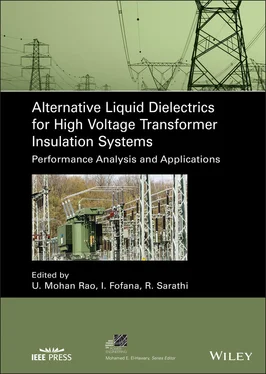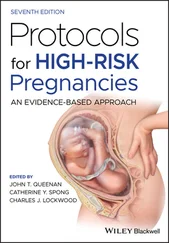E m), the components on
x ‐...Table 7.26 Magnitudes of electric field intensity in oil and pressboard, 0.1...Table 7.27 Comparison the parameters of distribution transformer filled with...Table 7.28 The measurement results of the performance parameters for the new...Table 7.29 Content of dissolved gases in oil after multiple times of surface...Table 7.30 Content of dissolved gases in oil after multiple times of surface...Table 7.31 Content of dissolved gases in oil after multiply AC breakdown of ...Table 7.32 Content of dissolved gases in oil after multiply AC breakdown of ...Table 7.33 Dissolved gases in oil after multiply positive polarity lightning...Table 7.34 Dissolved gases in oil after multiply positive polarity lightning...Table 7.35 Boundary settings of C 2H 2, H 2, C 2H 4triangle.
6 Chapter 8Table 8.1 Structure of glycerol, fatty acid, and triglyceride molecules [9].Table 8.2 Properties of commonly used nanoparticles.Table 8.3 Comparison of physical properties of mineral oil and natural ester...Table 8.4 Comparison of AC breakdown voltage of mineral oil and natural este...Table 8.5 Thermal conductivity of commonly used solids and liquids [57].
7 Chapter 9Table 9.1 Literature survey on nanofluids.Table 9.2 Arrhenius parameters for synthetic ester nanofluids.Table 9.3 Slope “m” and mobility under positive and negative polarity.Table 9.4 Number of corona discharges activity per second with synthetic est...
8 Chapter 10Table 10.1 Example of fault detected by Duval's triangle.Table 10.2 Example of fault detected by Duval's PentagonTable 10.3 Liquids classification and acidity values (measured).
9 Chapter 11Table 11.1 Power transformers analyzed in this study.Table 11.2 Comparison of heat run temperatures.Table 11.3 Dissolved gas content of oil in parts per million (ppm), taken ne...Table 11.4 Fluid properties.Table 11.5 90th percentile values determined from data.
1 Chapter 1 Figure 1.1 Basic insulation parameters for aging assessment of oil–paper ins... Figure 1.2 Conceptual illustration of degradation in oil filled apparatus....
2 Chapter 2 Figure 2.1 (a) Pongamia seeds, (b) Jatropha seeds. Figure 2.2 Processing of natural esters from seeds. Figure 2.3 (a) Mechanical extraction. (b) Chemical extraction. (c) Transeste... Figure 2.4 (a) Triglyceride structure. (b) Formation of fatty acid methyl es... Figure 2.5 Comparison of ACBDV values of different oil samples. Figure 2.6 (a) Parallel representation of the insulation. (b) Phasor diagram... Figure 2.7 Comparison of (a) pour point values of different oil samples and ... Figure 2.8 Comparison of viscosity values of different oil samples. Figure 2.9 (a) Aging test setup. (b) Oil samples depicting change of color d... Figure 2.10 FTIR spectrum of (a) FR3 aged at 1000 and 2000 hours along with ... Figure 2.11 NMR analysis of (a) new FR3, (b) aged FR3 for 2000 hours, (c) ne... Figure 2.12 (a) DGA analysis of aged FR3 and JAT – ethane, ethylene, and hyd...
3 Chapter 3 Figure 3.1 Different types of insulation according to manufacturing processe... Figure 3.2 Failures classified according to failure modes.Figure 3.3 (a) Hydrolysis of cellulose.(b) hydrolysis of esters and (c) ...Figure 3.4 Different mechanical properties of the paper insulation as a func...Figure 3.5 SEM of Kraft paper aged at 130 °C with (a) mineral oil for 261 ho...Figure 3.6 Transformer insulation life versus hottest‐spot temperature, desc...
4 Chapter 4Figure 4.1 Structure of natural ester.Figure 4.2 Structure of synthetic ester.Figure 4.3 Typical photographs of negative streamers in (a) synthetic ester ...Figure 4.4 Fifty percent breakdown voltage of ester fluids versus gap distan...Figure 4.5 Effect of moisture on the AC breakdown voltage of ester fluids.Figure 4.6 PDIV of ester fluids aged at different temperatures under differe...Figure 4.7 Electrical double‐layer formation and ion distribution at (a) oil...Figure 4.8 Molecular structure of cellulose.Figure 4.9 Test loop to simulate oil flow (1: pump, 2: heat regulation, 3: f...Figure 4.10 Ministatic charge tester.Figure 4.11 Couette charging apparatus with (a) front view on inner cylinder...Figure 4.12 Spinning disc system used for streaming electrification of insul...Figure 4.13 Schematic diagram of UV‐Visible spectroscopy measurement.Figure 4.14 UV‐visible absorption spectrum of ester fluid aged at (a) 90 °C,...Figure 4.15 Schematic diagram used for fluorescence measurement.Figure 4.16 EEM spectra of unaged ester fluid.Figure 4.17 EEM spectra of ester fluids aged at (a) 90 °C, (b) 140 °C and (c...Figure 4.18 Experimental setup used for dielectric response spectroscopy....Figure 4.19 Variation of dissipation factor with frequency for aged ester fl...Figure 4.20 IFT and turbidity of ester fluid during thermal aging.Figure 4.21 Viscosity of ester fluid aged at different temperatures.Figure 4.22 Surface potential measurement setup.Figure 4.23 Surface potential decay characteristics of thermally aged ester‐...Figure 4.24 Trap distribution characteristics under (a) positive corona and ...Figure 4.25 (a) Nyquist plot of thermally aged samples, (b) real part of imp...Figure 4.26 Equivalent circuit model.Figure 4.27 Relaxation time with aging temperature.Figure 4.28 (a) Electrical modulus spectrum, (b) real part of modulus with f...Figure 4.29 Variation of organic functional groups in pressboards aged at di...Figure 4.30 Experimental setup used for LIBS studies.Figure 4.31 (a) LIBS emission spectra of aged pressboard, (b) LIBS intensity...
5 Chapter 5Figure 5.1 Illustration of decay particles and their influence on transforme...Figure 5.2 Illustration of the experimental and centrifuge treatment. (a). I...Figure 5.3 Visualization indicating no evidence of colloidal particles in es...Figure 5.4 UV/Vis curves for aged and treated liquids (a) at 115 °C, (b) at ...Figure 5.5 Turbidity of the aged liquids and centrifuged mineral oil.Figure 5.6 Particle count for aged liquids and centrifuged mineral oil (a) a...Figure 5.7 Illustration of the experimental and view of filtering setup. (a)...Figure 5.8 UV/Vis spectral curves for aged oils and filtered oils (a) at 115...Figure 5.9 Absorbance of aged and filtered liquids.Figure 5.10 Turbidity of aged and filtered liquids.Figure 5.11 Particle count for aged oils and filtered oils (a) at 115 °C, (b...Figure 5.12 Variations of turbidity and dissolved decay content with filtrat...Figure 5.13 Variations of turbidity and dissolved decay content with filtrat...
6 Chapter 6Figure 6.1 Dependence inception voltage (a) and inception electrical field s...Figure 6.2 Influence of radius of curvature of high‐voltage point (with d = ...Figure 6.3 Relationship between propagation velocity of the streamers in die...Figure 6.4 Relationship between propagation velocity and testing voltage for...Figure 6.5 Dependence of propagation velocity of negative streamers versus i...Figure 6.6 The sequence of shadowgraph photos of the streamers developing in...Figure 6.7 Examples of shadowgraph photos of third mode streamers developing...Figure 6.8 Examples of light oscillograms registered under positive LI volta...Figure 6.9 Shape of long, positive second mode streamers at 25 μs, shortly b...Figure 6.10 Streamer development according to the liquid phase ionization.Figure 6.11 Literature examples showing the influence of additives on propag...Figure 6.12 Streamer stopping length at various LI voltage (gap distance = 2...Figure 6.13 Examples of light and voltage waveforms registered at negative p...Figure 6.14 Schematic of the experimental setup. Tf: Transformer; D1: Capaci...Figure 6.15 Viscosity of the liquids with change in temperature.Figure 6.16 PD and BDV behavior of natural esters with change in temperature...Figure 6.17 PD behavior of esters with thermal aging. (a) PDIV for different...
7 Chapter 7Figure 7.1 Kinematic viscosity, specific heat capacity, thermal conductivity...Figure 7.2 Variation in the moisture content and saturated water content of ...Figure 7.3 Test results of degree of polymerization (DP) values during the a...Figure 7.4 PDSC and thermogravimetric decomposition characteristics of diffe...Figure 7.5 Acid values of insulation oils and acid catalyzes the hydrolysis ...Figure 7.6 Weibull distribution of AC breakdown voltage of mineral oil and t...Figure 7.7 Comparison of Weibull breakdown voltages and saturated water cont...Figure 7.8 AC breakdown voltage of insulation oil with the combined effects ...Figure 7.9 Breakdown voltage, relative permittivity, dielectric loss, and sp...Figure 7.10 Electrode structure and the transient simulation result of elect...Figure 7.11 Breakdown voltages of oil‐immersed pressboards with different oi...Figure 7.12 Transient simulation result of electric field distribution at th...Figure 7.13 Weibull distributions of surface flashover voltages and comparis...Figure 7.14 Weibull distributions of surface flashover voltages and comparis...Figure 7.15 Weibull distributions of breakdown voltages under needle‐plate a...Figure 7.16 Electric field distribution simulation result of the 3EMO‐IP und...Figure 7.17 Electric field intensity along the axis of the two electrodes fo...Figure 7.18 Distribution transformer filled by the new three‐element mixed i...Figure 7.19 Content of dissolved gases in these five gases in MO and TEMO af...Figure 7.20 Content of dissolved gases in these five gases in MO–paper and T...Figure 7.21 Percentage of H 2, CH 4, C 2H 4, C 2H 6and C 2H 2in these five gases o...Figure 7.22 Percentage of H 2, CH 4,C 2H 4, C 2H 6and C 2H 2in these five gases d...Figure 7.23 Percentage of H 2, CH 4,C 2H 4, C 2H 6, and C 2H 2in these five gases ...Figure 7.24 Percentage of H 2, CH 4,C 2H 4, C 2H 6and C 2H 2in these five gases a...Figure 7.25 C 2H 2, H 2, C 2H 4triangle for diagnosing thermal and electrical fa...
Читать дальше












